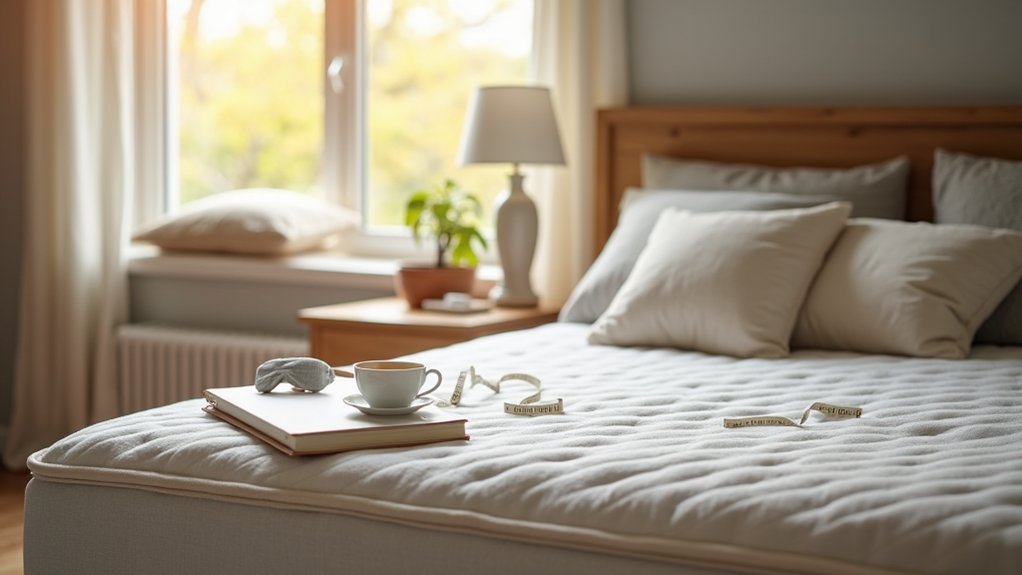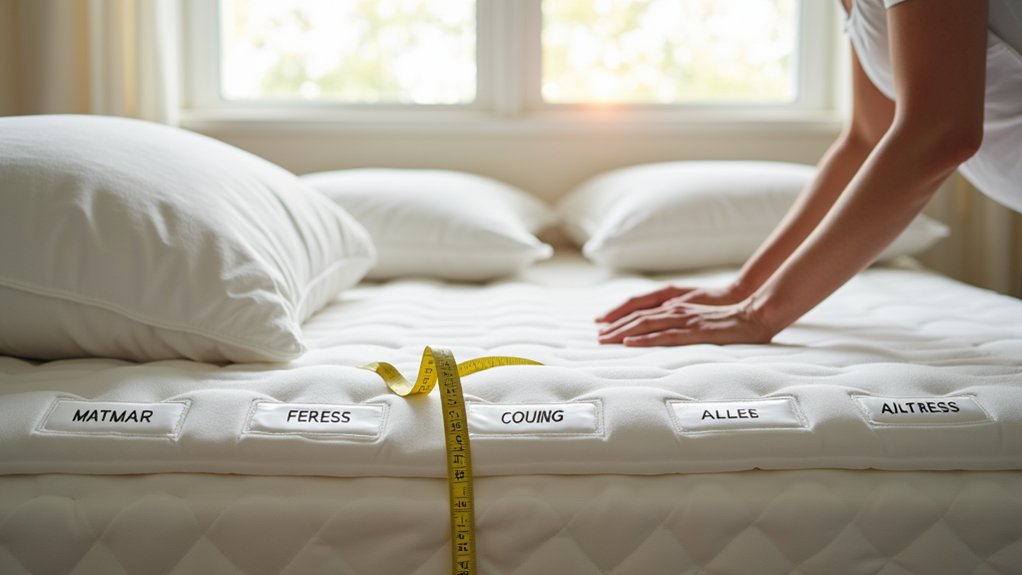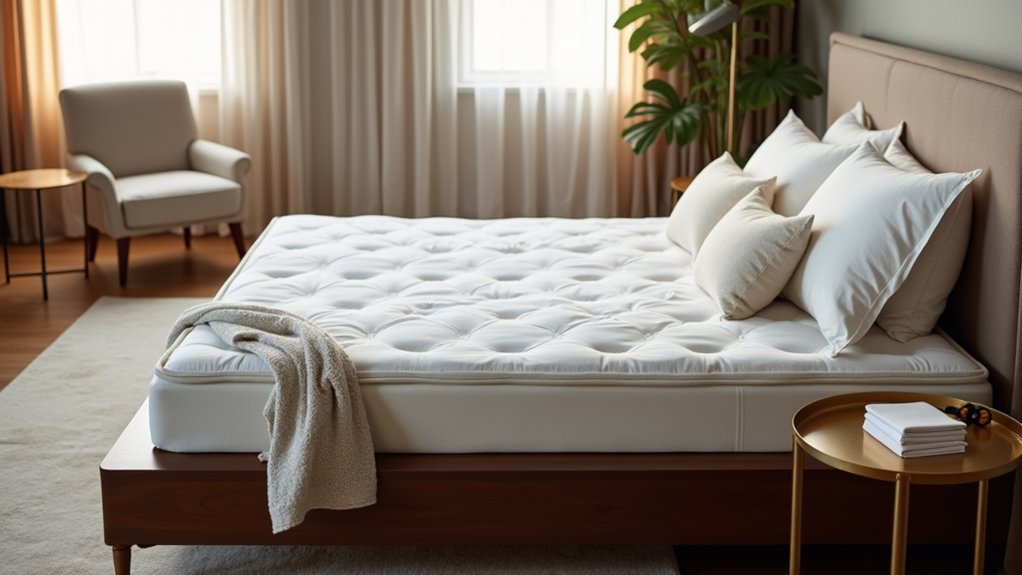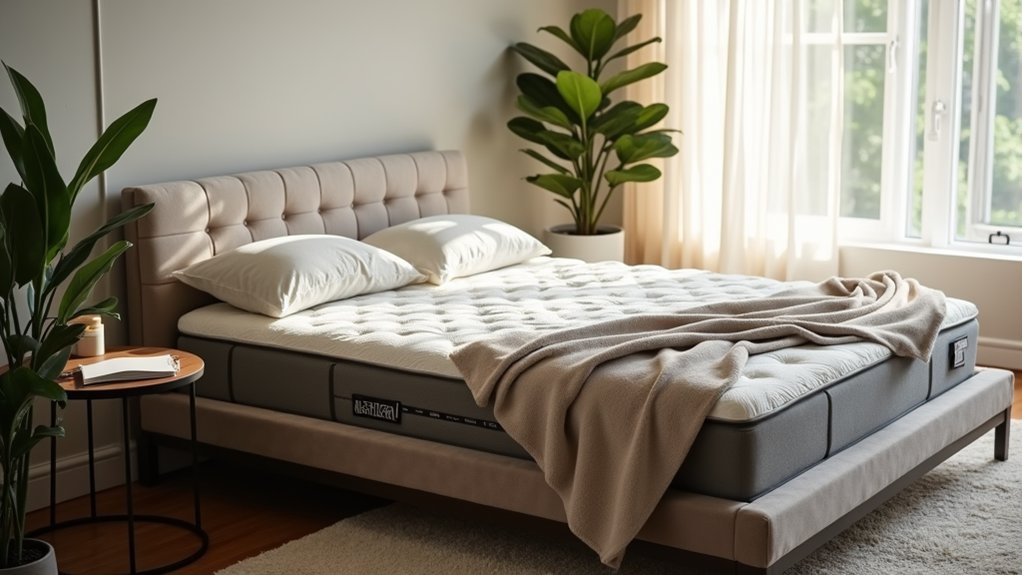How to Buy the Perfect Mattress for You
Did you know that your sleep position greatly impacts the type of mattress you'll need for ideal comfort? Many people overlook this vital factor, leading to poor sleep quality and discomfort. To find the perfect mattress for you, it's important to assess your individual sleep needs and preferences. But with so many options available, how do you determine which features truly matter? Understanding the nuances of mattress types, firmness levels, and materials is key to making an informed decision. Let's explore what you should consider before making this significant investment.
Determining Your Sleep Needs

When it comes to buying the perfect mattress, understanding your sleep needs is fundamental. Your age and developmental stage greatly influence how much sleep you require. For instance, newborns need 14-17 hours, while adults typically need 7-9 hours. Knowing this helps you prioritize your sleep environment.
Genetic and biological factors also play a role. Some people are natural "larks," preferring early mornings, while others are "owls," thriving at night. These genetic traits affect your sleep patterns, making it essential to take into account when selecting a mattress. Additionally, certain genes linked to sleep duration can influence how rested you feel upon waking.
Lifestyle and health factors can't be overlooked. Physically demanding jobs or chronic illnesses often increase sleep needs. Stress and anxiety can disrupt your sleep, so your mattress should provide adequate support to alleviate discomfort.
Lastly, environmental factors contribute to sleep quality. A quiet, dark, and comfortable space is critical. Verify your mattress fits well within your sleep environment to minimize disturbances.
Exploring Mattress Types
Choosing the right mattress type can considerably impact your sleep quality, as each offers unique benefits tailored to different preferences and needs. Here's a breakdown of popular mattress types to help you decide.
Innerspring Mattresses
- Materials: Steel coil support system.
- Benefits: Firmness and bounce; excellent support and ventilation.
- Best For: Side and back sleepers, those with lower back pain, and restless sleepers.
- Cons: Potential sagging over time and motion transfer.
Memory Foam Mattresses
- Contouring: Conforms to your body with pressure and heat.
- Benefits: Excellent pressure relief; evenly distributes body weight.
- Cons: Can retain heat, though newer models have cooling features.
Latex Mattresses
- Materials: Natural or synthetic rubber.
- Benefits: Balanced softness and support; hypoallergenic options available.
- Best For: Eco-conscious shoppers and hot sleepers.
Hybrid Mattresses
- Combination: Blends foam with a coil unit.
- Benefits: Balanced feel; improved cooling and bounce.
- Best For: Those wanting the best of both foam and innerspring.
Understanding these differences will help you select a mattress that meets your specific sleep needs.
Understanding Firmness Levels

After exploring various mattress types, understanding firmness levels is essential for finding the perfect fit for your sleep style.
Firmness is measured on a scale from 1 to 10, where:
- 1: Extra Soft (significant sinkage)
- 2-3: Soft (noticeable sinkage)
- 4-7: Medium to Medium Firm (some sinkage)
- 8-10: Firm to Extra Firm (minimal sinkage)
Your sleeping position greatly influences the firmness you should choose.
For example:
- Side sleepers benefit from Soft to Medium Firm (2-6) for pressure relief.
- Back sleepers require Medium to Firm (5-8) to maintain spinal alignment.
- Stomach sleepers need Firm to Extra Firm (7-9) to prevent excessive sinkage.
Body type also plays a role.
Lighter individuals (<130 lbs) often prefer Soft to Medium Soft (2-4), while average-weight sleepers (130-230 lbs) lean toward Medium to Medium Firm (5-6). It's important to note that average firmness preferences vary by body weight, influencing the best choice for individual comfort.
Heavier sleepers (>230 lbs) typically favor Medium Firm to Firm (6-8).
Evaluating Materials and Construction
- Types: Natural latex is eco-friendly, while synthetic latex may contain harmful chemicals. Organic latex is processed without these chemicals.
- Benefits: Latex offers breathability and resilience, with excellent bounce and pressure relief. It's durable and hypoallergenic. Additionally, latex mattresses generally have lower chemical exposure than memory foam.
- Considerations: Natural latex can be pricier, and synthetic options may lack longevity. Always check for fillers to understand the natural-synthetic ratio.
Memory Foam Mattresses
- Types: High-density, gel-infused, and polyfoam varieties exist, often available in hybrid forms.
- Benefits: Memory foam excels in pressure relief and motion isolation, making it ideal for side sleepers.
- Considerations: It can retain heat and may emit a chemical odor initially. Weigh the durability against your needs.
Innerspring Mattresses
- Types: Traditional, pocketed coils, and hybrids combine innerspring with other materials.
- Benefits/Drawbacks: These mattresses offer firmness but can lack the comfort of foam or latex options. They are also the most common and affordable type, making them a popular choice for budget-conscious shoppers.
Choosing the Right Size

When you're ready to select the right mattress size, consider your room dimensions and sleeping habits. Here are key factors to guide your decision:
Room Size
- Make certain you have at least 2 feet of free space around the mattress for easy movement.
- California King: Ideal for rooms of 12 feet by 12 feet.
- King: Requires a minimum of 12 feet by 12 feet.
- Queen: Suitable for couples but may feel tight for those who prefer more space.
- Full: Best for single sleepers or couples who don't need much room.
- Twin/Twin XL: Fits well in smaller spaces, like 9 feet 6 inches by 10 feet 6 inches. Proper fit enhances overall bedroom aesthetics.
Height and Length
Choose a mattress that's at least 6 inches longer than the tallest sleeper. For tall individuals, California King mattresses (72" x 84") offer extra length, while King mattresses are 4 inches shorter but wider.
Comfort and Usage
Consider how you'll use the mattress. Make certain it's wide enough for comfort and long enough to prevent feet from hanging off. This attention to detail will enhance your overall sleep experience.
Shopping and Purchase Tips
How can you guarantee you're making the best mattress purchase? Start by understanding your sleep needs. Assess your sleep position, health concerns, body type, and temperature regulation. For instance, back sleepers often benefit from medium-firm mattresses, while side sleepers may need softer options for pressure relief.
Next, select the right mattress type. Consider innerspring for traditional support, memory foam for contouring comfort, latex for breathability, or hybrids for balanced support. Adjustable mattresses can also accommodate different preferences, especially for couples. Additionally, be mindful of your unique sleeping issues, such as being a hot sleeper or experiencing back pain, as these factors can significantly influence your mattress choice.
When testing mattresses, spend at least 15 minutes lying on each one in your usual position. If shopping online, read customer reviews for insights on feel and support. Look for mattresses with trial periods of at least 100 nights to ascertain satisfaction.
Set a budget and compare prices across retailers. Keep an eye out for sales, discounts, and financing options to manage payments effectively.
Finally, understand the warranty and return policies to avoid hidden fees. By following these shopping tips, you'll be better equipped to make an informed mattress purchase tailored to your specific needs.





